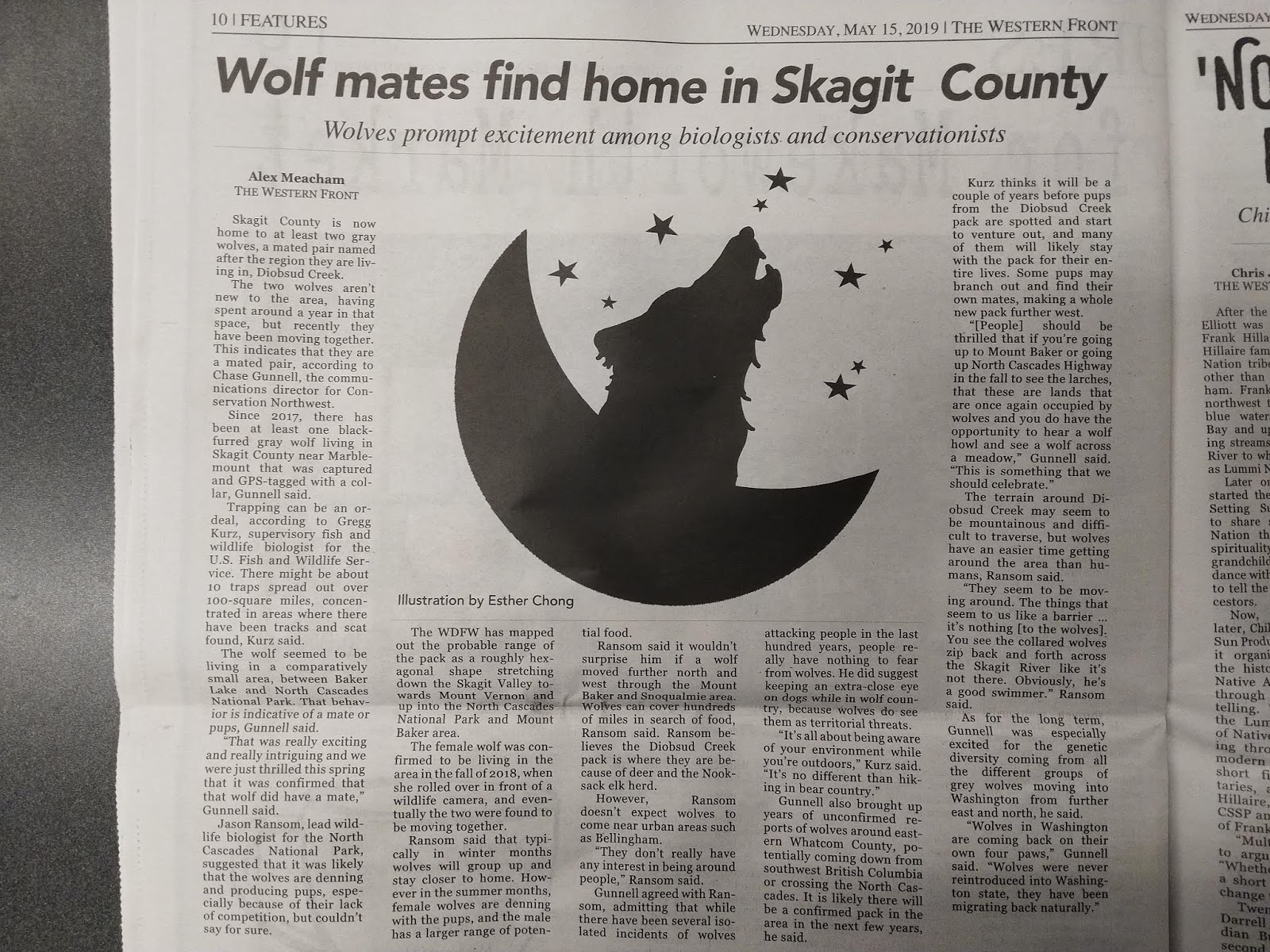Wolf Mates Find Home in Skagit County
Published 5.15.2019 - By Alex Meacham
Skagit County is now home to at least two gray wolves, a mated pair named after the region they are living in, Diobsud Creek.
The two wolves aren’t new to the area, having spent around a year in that space, but recently they have been moving together. This indicates that they are a mated pair, according to Chase Gunnell, the communications director for Conservation Northwest.
Since 2017, there has been at least one black-furred gray wolf living in Skagit County near Marblemount that was captured and GPS-tagged with a collar, Gunnell said.
Trapping can be an ordeal, according to Gregg Kurz, supervisory fish and wildlife biologist for the U.S. Fish and Wildlife Service. There might be about 10 traps spread out over 100-square miles, concentrated in areas where there have been tracks and scat found, Kurz said.
The wolf seemed to be living in a comparatively small area, between Baker Lake and North Cascades National Park. That behavior is indicative of a mate or pups for the wolf, Gunnell said.
“That was really exciting and really intriguing and we were just thrilled this spring that it was confirmed that that wolf did have a mate,” said Gunnell.
Jason Ransom, lead wildlife biologist for the North Cascades National Park, suggested that it was likely that the wolves are denning and producing pups, especially because of their lack of competition, but couldn’t say for sure.
The WDFW has mapped out the probable range of the pack as a roughly hexagonal shape stretching down the Skagit Valley towards Mount Vernon and up into the North Cascades National Park and Mount Baker area.
The female wolf was confirmed to be living in the area in the fall of 2018, when she rolled over in front of a wildlife camera, and eventually the two were found to be moving together.
Ransom said that typically in winter months wolves will group up and stay closer to home, compared to summer months when female wolves are denning with the pups, and the male has a larger range of potential food.
Ransom said that it wouldn’t surprise him if a wolf moved further north and west through the Mount Baker and Snoqualmie area. Wolves can cover hundreds of miles in search of food, Ransom said. Ransom believes the Diobsud Creek pack is where they are because of deer and the Nooksack elk herd.
However, Ransom doesn’t expect wolves to come near urban areas such as Bellingham.
“They don’t really have any interest in being around people,” Ransom said.
Gunnell agreed with Ransom, admitting that while there have been several isolated incidents of wolves attacking people in the last hundred years, people really have nothing to fear from wolves. He did suggest keeping an extra-close eye on dogs while in wolf country, because wolves do see them as territorial threats.
“It’s all about being aware of your environment while you’re outdoors,” Kurz said. “It’s no different than hiking in bear country.”
Gunnell also brought up years of unconfirmed reports of wolves around eastern Whatcom County, potentially coming down from southwest British Columbia or crossing the North Cascades. It is likely there will be a confirmed pack in the area in the next few years, he said.
Kurz thinks it will be a couple of years before pups from the Diobsud Creek pack are spotted and start to venture out, and many of them will likely stay with the pack for their entire lives. Some pups may branch out and find their own mates, making a whole new pack further west.
“[People] should be thrilled that if you’re going up to Mount Baker or going up North Cascades Highway in the fall to see the larches, that these are lands that are once again occupied by wolves and you do have the opportunity to hear a wolf howl and see a wolf across a meadow,” Gunnell said. “This is something that we should celebrate.”
The terrain around Diobsud Creek may seem to be mountainous and difficult to traverse, but wolves have an easier time getting around the area than humans, Ransom said.
“They seem to be moving around,” Ransom said. “The things that seem to us like a barrier… it’s nothing [to the wolves]. You see the collared wolves zip back and forth across the Skagit River like it’s not there. Obviously, he’s a good swimmer.”
As for the long term, Gunnell was especially excited for the genetic diversity coming from all the different groups of grey wolves moving into Washington from further east and north, he said.
“Wolves in Washington are coming back on their own four paws,” Gunnell said. “Wolves were never reintroduced into Washington state, they have been migrating back naturally.”

Skagit County is now home to at least two gray wolves, a mated pair named after the region they are living in, Diobsud Creek.
The two wolves aren’t new to the area, having spent around a year in that space, but recently they have been moving together. This indicates that they are a mated pair, according to Chase Gunnell, the communications director for Conservation Northwest.
Since 2017, there has been at least one black-furred gray wolf living in Skagit County near Marblemount that was captured and GPS-tagged with a collar, Gunnell said.
Trapping can be an ordeal, according to Gregg Kurz, supervisory fish and wildlife biologist for the U.S. Fish and Wildlife Service. There might be about 10 traps spread out over 100-square miles, concentrated in areas where there have been tracks and scat found, Kurz said.
The wolf seemed to be living in a comparatively small area, between Baker Lake and North Cascades National Park. That behavior is indicative of a mate or pups for the wolf, Gunnell said.
“That was really exciting and really intriguing and we were just thrilled this spring that it was confirmed that that wolf did have a mate,” said Gunnell.
Jason Ransom, lead wildlife biologist for the North Cascades National Park, suggested that it was likely that the wolves are denning and producing pups, especially because of their lack of competition, but couldn’t say for sure.
The WDFW has mapped out the probable range of the pack as a roughly hexagonal shape stretching down the Skagit Valley towards Mount Vernon and up into the North Cascades National Park and Mount Baker area.
The female wolf was confirmed to be living in the area in the fall of 2018, when she rolled over in front of a wildlife camera, and eventually the two were found to be moving together.
Ransom said that typically in winter months wolves will group up and stay closer to home, compared to summer months when female wolves are denning with the pups, and the male has a larger range of potential food.
Ransom said that it wouldn’t surprise him if a wolf moved further north and west through the Mount Baker and Snoqualmie area. Wolves can cover hundreds of miles in search of food, Ransom said. Ransom believes the Diobsud Creek pack is where they are because of deer and the Nooksack elk herd.
However, Ransom doesn’t expect wolves to come near urban areas such as Bellingham.
“They don’t really have any interest in being around people,” Ransom said.
Gunnell agreed with Ransom, admitting that while there have been several isolated incidents of wolves attacking people in the last hundred years, people really have nothing to fear from wolves. He did suggest keeping an extra-close eye on dogs while in wolf country, because wolves do see them as territorial threats.
“It’s all about being aware of your environment while you’re outdoors,” Kurz said. “It’s no different than hiking in bear country.”
Gunnell also brought up years of unconfirmed reports of wolves around eastern Whatcom County, potentially coming down from southwest British Columbia or crossing the North Cascades. It is likely there will be a confirmed pack in the area in the next few years, he said.
Kurz thinks it will be a couple of years before pups from the Diobsud Creek pack are spotted and start to venture out, and many of them will likely stay with the pack for their entire lives. Some pups may branch out and find their own mates, making a whole new pack further west.
“[People] should be thrilled that if you’re going up to Mount Baker or going up North Cascades Highway in the fall to see the larches, that these are lands that are once again occupied by wolves and you do have the opportunity to hear a wolf howl and see a wolf across a meadow,” Gunnell said. “This is something that we should celebrate.”
The terrain around Diobsud Creek may seem to be mountainous and difficult to traverse, but wolves have an easier time getting around the area than humans, Ransom said.
“They seem to be moving around,” Ransom said. “The things that seem to us like a barrier… it’s nothing [to the wolves]. You see the collared wolves zip back and forth across the Skagit River like it’s not there. Obviously, he’s a good swimmer.”
As for the long term, Gunnell was especially excited for the genetic diversity coming from all the different groups of grey wolves moving into Washington from further east and north, he said.
“Wolves in Washington are coming back on their own four paws,” Gunnell said. “Wolves were never reintroduced into Washington state, they have been migrating back naturally.”



Comments
Post a Comment